TAXANGLES A newsletter for proactive planning... In this edition... January 2021 Issue • What tax do I need to pay by 31 January 2021? www.compassaccountants.co.uk • Make the most of the dividend allowance • Reclaiming SSP for periods of self-isolation • Leaving the VAT Flat Rate Scheme • Auto-enrolment – Re-enrolment and re-declaration of compliance • 10 Questions with... Kerry Sweeney
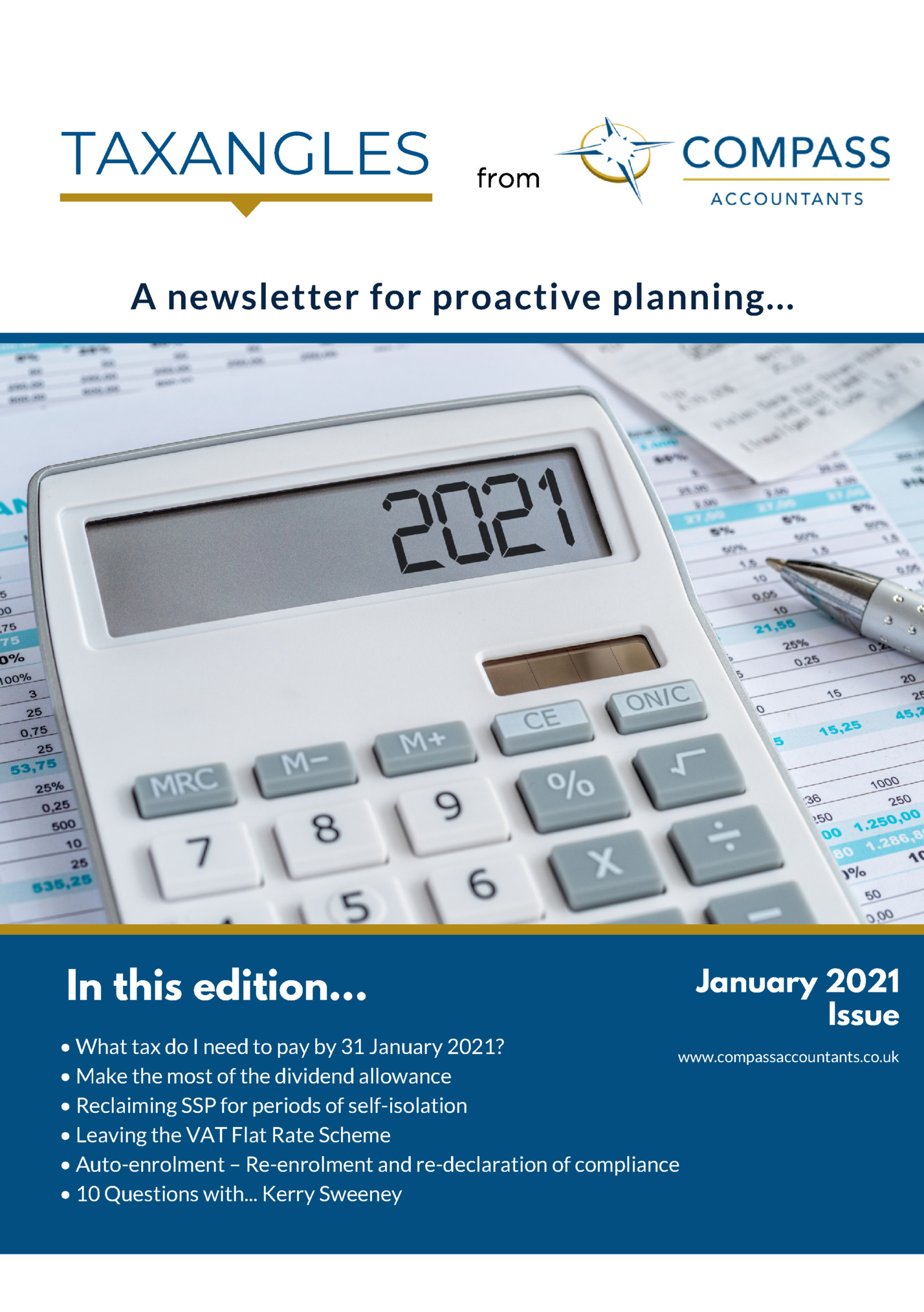
PAGE 2 What tax do I need to pay by 31 January 2021? The self-assessment tax return for 2019/20 must be filed by midnight on 31 January 2021. If you miss this deadline, you will automatically receive a late filing penalty of £100, regardless of whether you owe any tax, unless you are able to convince HMRC that you have a reasonable excuse for filing your tax return after the deadline. You must also pay any outstanding tax that you owe for 2019/20 by 31 January 2021, unless you have agreed a Time to Pay agreement with HMRC. The amount of tax that is outstanding for 2019/20 will depend on whether you opted to defer payment of the second payment on account for 2019/20, which would ordinarily have been due by 31 July 2020. To help taxpayers who were struggling financially as a result of the Covid-19 pandemic, selfassessment taxpayers could opt to delay payment of the second payment on account for 2019/20, paying it instead by 31 January 2021. Where this option was taken, the balance owing for 2019/20 will be the total liability for the year (tax plus, where relevant, Class 2 and Class 4 National Insurance), less any amount paid on account by 31 January 2020. If you decided instead to pay your July payment on account as normal (or if you paid it later than normal but have now paid it in full), you will only owe tax for 2019/20 if the total liability is more than what has already been paid on account. Payments on account If your total tax and Class 4 National Insurance liability was at least £1,000 for 2019/20 and less than 80% of your total liability is collected at source, for example, under PAYE, you will need to make payments on account for 2020/21. Each payment is 50% of the 2019/20 tax and Class 4 National Insurance liability. The first payment is due by 31 January 2021, along with any tax owing for 2019/20. The second payment should be paid by 31 July 2021. Struggling to pay? For many, 2020 has been a difficult year financially. Where the option to delay the July 2020 payment on account has been taken, taxpayers may struggle to pay the higher than normal January tax bill in full by 31 January 2021. Where this is the case, they can agree with HMRC to pay the tax that they owe in instalments. If the amount that is owed is £30,000 or less, an agreement can be set up online. Where the amount outstanding is more than £30,000 or the taxpayer needs more than 12 months to pay, contact HMRC to discuss setting up an arrangement to suit. As payments on account for 2020/21 are based on pre-pandemic profits, consider reducing the payments if profits for 2020/21 are likely to be lower.

PAGE 3 PAGE 3 Make the most of the dividend allowance The 2020/21 tax year comes to an end on 5 April 2021. The last few months of the year are a good time to undertake a review and to ensure that allowance for the year is not wasted. Nature of the dividend allowance One allowance that is available to all taxpayers, regardless of the rate at which they pay tax, is the dividend allowance. The allowance is set £2,000 for 2020/21. Although called an ‘allowance’, the dividend allowance is more of a nil rate band. Dividends sheltered by the allowance are taxed at a zero rate of tax. However, the dividends covered by the allowance count towards band earnings. Once the dividend allowance and any remaining personal allowance have been used up, any further dividend income (treated as the top slice of income) is taxed at the relevant dividend tax rate: • 7.5 for dividends falling within the basic rate band; • 32.5% for dividends falling within the higher rate band; and • 38.1% for dividends falling within the additional rate band. Personal and family companies If you have a personal company and have sufficient retained profits, consider paying a dividend if you have not already done so to mop up your dividend allowance and any unused personal allowance. Although dividends are paid from profits which have already suffered corporation tax, the availability of the dividend allowance allows retained profits to be extracted without incurring any additional tax. A further benefit is that there is no National Insurance to pay on dividends. In a family company scenario, making family members shareholders provides scope for family members to utilise their dividend allowances, allowing profits to be extracted in a tax-efficient manner. There are some points to watch. Dividends can only be paid from retained profits and must be paid in proportion to shareholdings. However, the use of an alphabet share structure whereby each family member has a different class of shares (e.g. A shares for one person, B shares for another, and so on) provides the flexibility to declare different dividends for each person, depending on their available allowances and their marginal rate of tax. Example: Mr Wilson is a director of W Ltd. His wife and two adult daughters, Emily and Evie, are both shareholders. The shareholdings are as follows • Mr Wilson – 100 A Ordinary shares; • Mrs Wilson – 100 B Ordinary shares; • Emily Wilson – 100 C Ordinary shares • Evie Wilson – 100 D Ordinary shares. Mr Wilson is a higher rate taxpayer. None of the family has used their dividend allowance for 2020/21. Mr Wilson wishes to declare a dividend of £8,000 for 2020/21. If he declares a dividend £80 per share for A ordinary shares only, he will receive a dividend of £8,000, of which the first £2,000 will be covered by the dividend allowance of £2,000. The remaining £6,000 will be taxed at the higher dividend rate of 32.5%, giving rise to a tax bill of £1,950. However, if instead, he declares a dividend of £20 per share for A, B C and D Ordinary Shares, each member of the family will receive a dividend of £2,000, which will be sheltered by their dividend allowance and received tax-free. By taking this route, the family’s tax bill is reduced by £1,950.
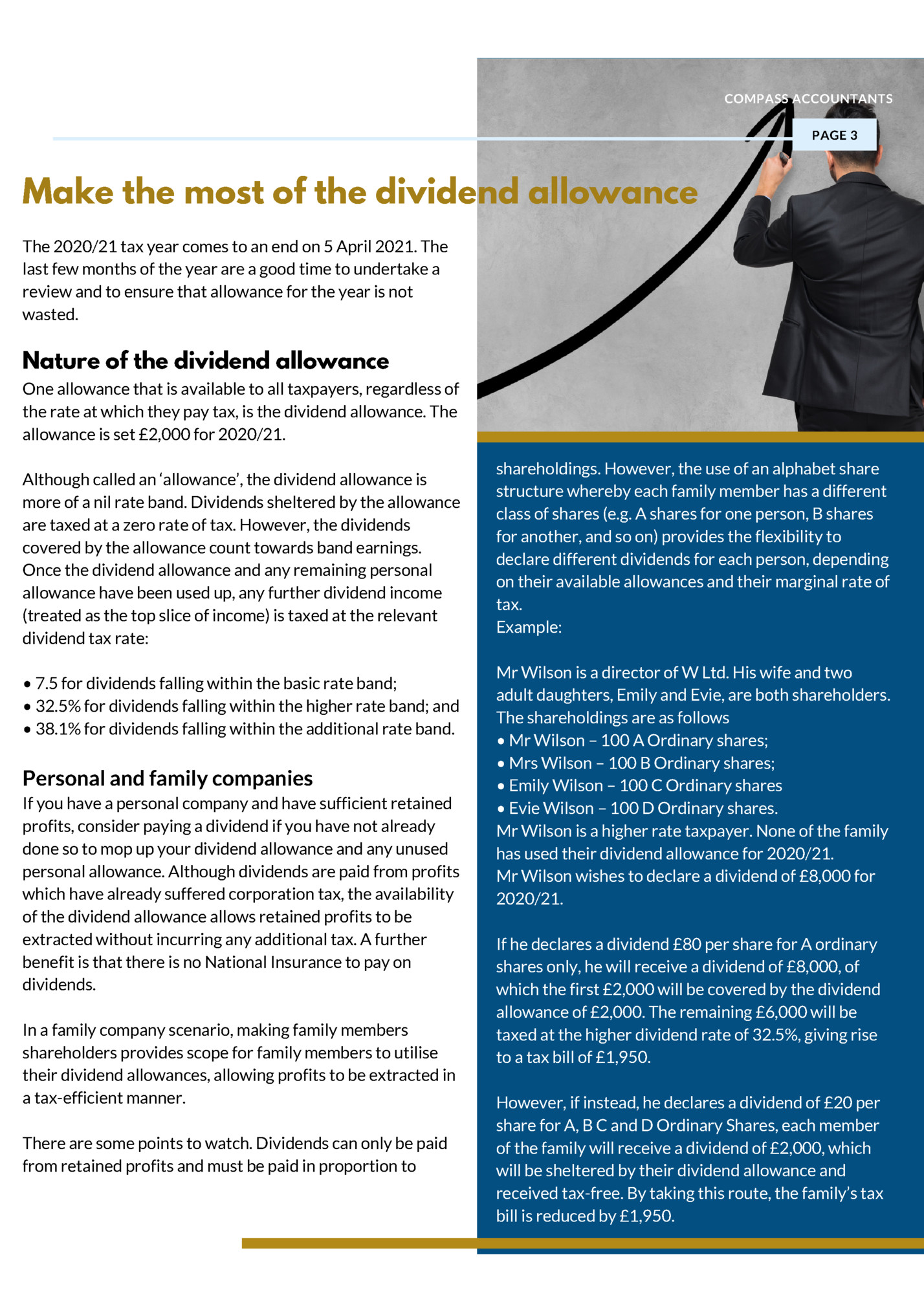
PAGE 4 Reclaiming SSP for periods of self-isolation The Coronavirus Statutory Sick Pay Rebate Scheme allows smaller employers to reclaim some or all of the Statutory Sick Pay (SSP) paid to employees who are absent from work due to a Coronavirus-related absence. Eligible employers An employer is eligible to use the scheme if the employer had fewer than 250 employees across all their PAYE payroll schemes on 28 February 2020 and has paid sick pay to an employee who was absent from work as a result of a Coronavirus-related absence. The ability to reclaim SSP is not limited to that payable to employees with Coronavirus symptoms; it also applies to SSP paid to employees who are required to shield or to self-isolate as a result of Covid-19. Reclaiming SSP related to periods of self-isolation An employee is eligible for SSP if: • they are self-isolating because someone that they live with has Coronavirus symptoms or has tested positive for Covid19; • they have been told to isolate by the NHS or a public health body because they have been in contact with someone who has tested positive for Covid-19; or • they have been notified by the NHS to self-isolate before surgery for up to 14-days. SSP payable from first day of sickness The SSP rules have been relaxed in relation to Coronavirus absences and employees can receive SSP from the first day of a Coronavirus-related absence – the three waiting days do not need to be served before SSP is payable (as is the case for non-Covid absences). 5 g p -t n o C
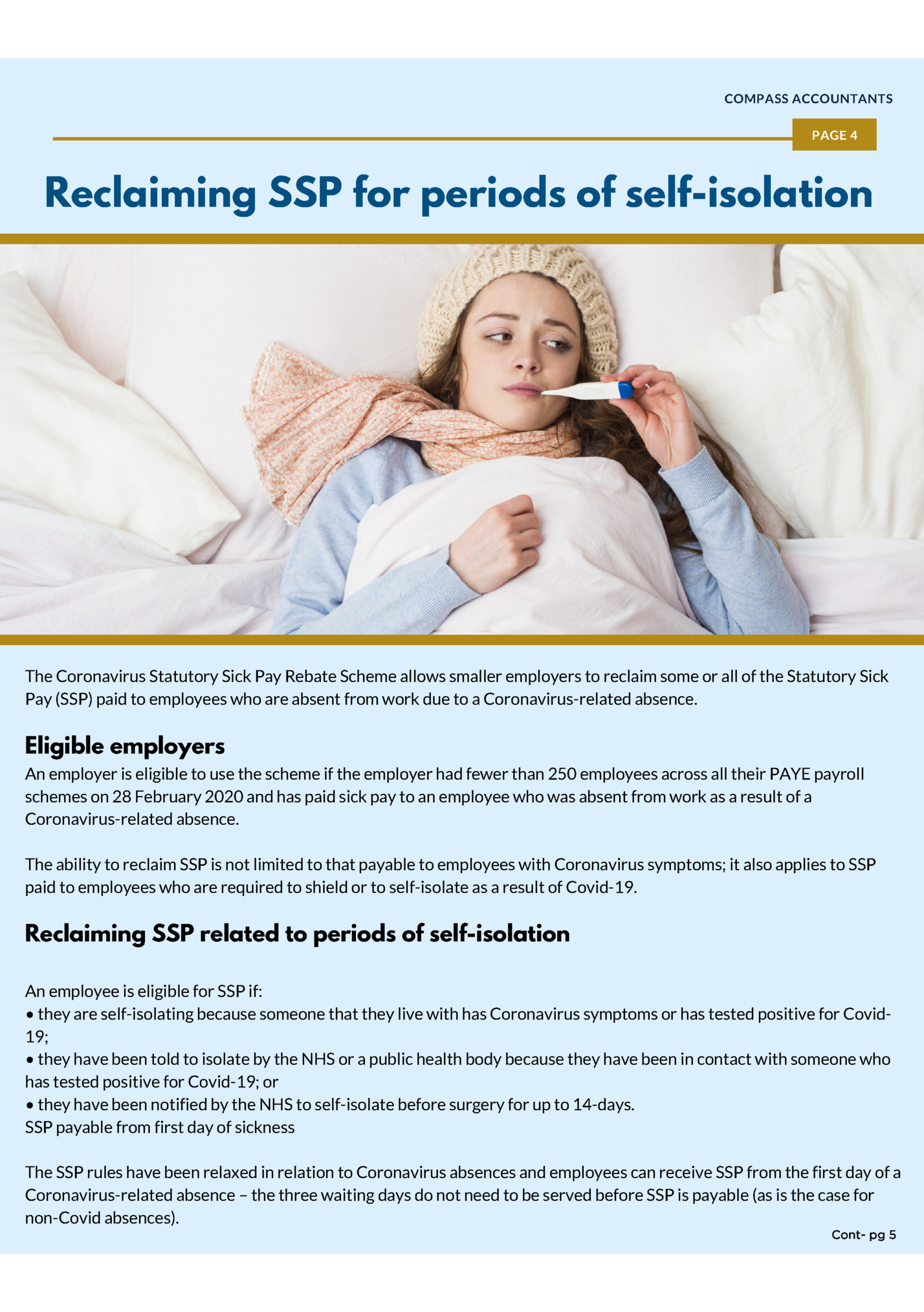
PAGE 5 As far as periods of self-isolation are concerned, SSP can be paid from the first day that the employee is off work because they are self-isolating where the period of self-isolation: • started on or after 13 March 2020 where someone they live with has Coronavirus symptoms or is self-isolating; • started on or after 28 May 2020 where the employee was notified by the NHS that have come into contact with someone who tested positive for Coronavirus; and • started on or after 26 August 2020 where the employee was notified by the NHS of the need to self-isolate prior to surgery. Where an employee is required to self-isolate prior to surgery, only the days of self-isolation count as a Coronavirusrelated absence. Any SSP paid for the day of the surgery and any recover days is not related to Coronavirus and cannot be reclaimed. Reclaiming SSP Eligible employers can reclaim up to two weeks’ SSP per employee where the employee has been absent from work due to Coronavirus, including where the employee is self-isolating or shielding. The claim can cover more than one period of absence, but where an employee has been absent from work for more than two weeks due to Coronavirus, the claim is capped at two weeks’ SSP – the employer must bear the cost of any further SSP paid. Claims can be made online via the portal on the Gov.uk website. Leaving the VAT Flat Rate Scheme The VAT Flat rate scheme is a simplified scheme for smaller businesses. Under the flat rate scheme, VATregistered traders pay a fixed percentage of their VAT inclusive turnover to HMRC instead of the difference between the VAT that they charge and the VAT than they incur. The flat rate percentage depends on the business sector within which the trader operates. With the exception of certain capital assets costing more than £2,000, the trader cannot reclaim the VAT on purchases; the flat rate percentage includes an allowance for input VAT. Joining the scheme Traders can apply to join the flat rate scheme if their turnover, excluding VAT, is £150,000 or less. Leaving the scheme: Once in the flat rate scheme, a trader must leave it if: • they are no longer eligible to be in the scheme; • on the anniversary of joining turnover in the last 12 months (including VAT) was more than £230,000; 6 gp no tnoC
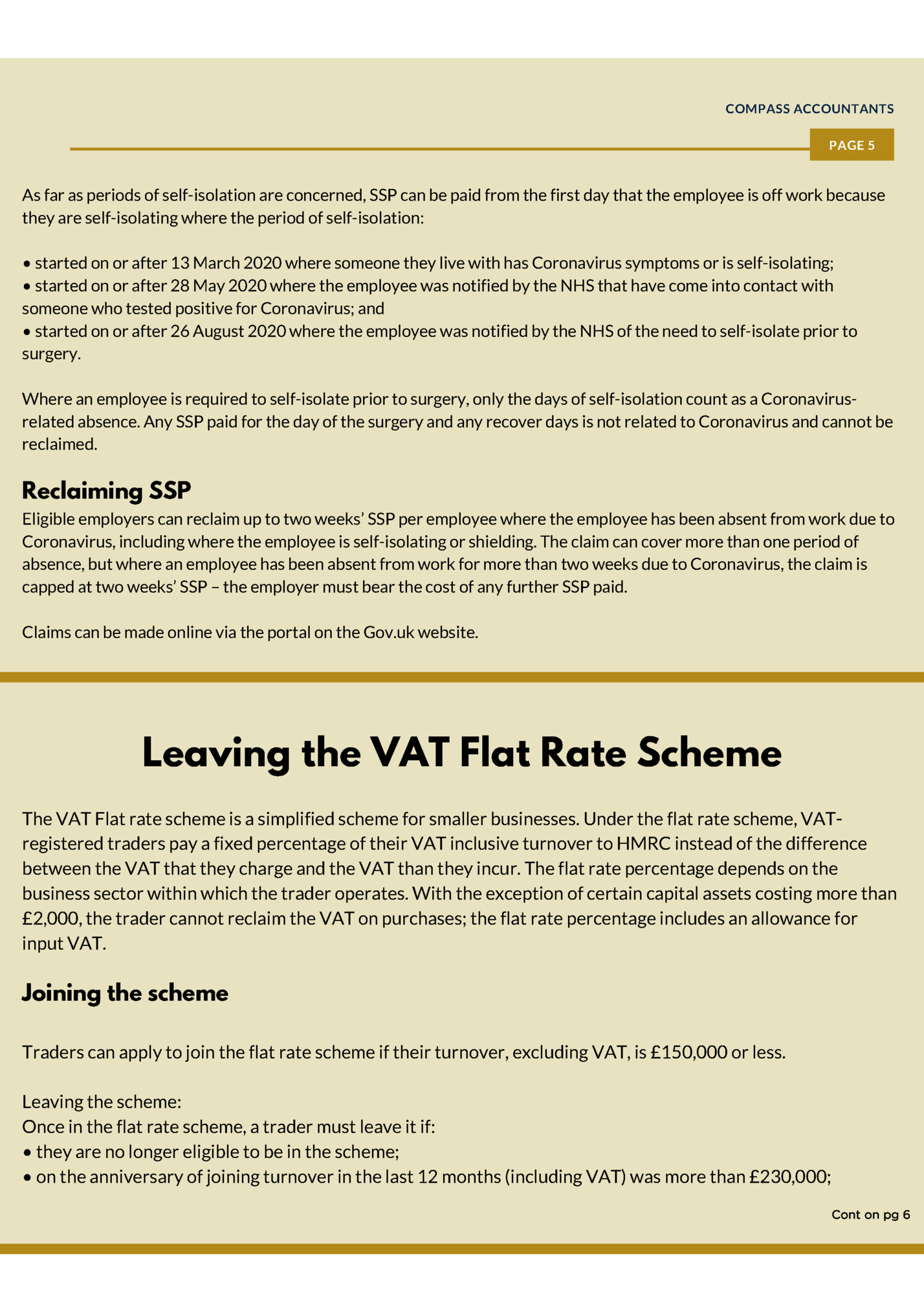
turnover in the next 30 days is expected to be more than £230,000 (including VAT); • they become a tour operator and have to account for VAT using the Tour Operator’s Margin Scheme; • the trader intends to buy capital goods covered by the Capital Goods Scheme; • the trader becomes eligible to join an existing VAT group; or • the trader becomes associated with another business. Traders also choose to leave the scheme if they decide it is no longer for them. Once a trader has left the scheme, they cannot re-join it for at least 12 months. It the scheme still worthwhile? The flat rate percentage for limited cost businesses is 16.5% of VAT-inclusive turnover. This equates to 19.8% of VAT-exclusive turnover, which means that virtually all the VAT charged to customers is paid over to HMRC, with very little allowance to cover input VAT. A business is a limited cost business if the cost of its relevant goods is less than 2% of its turnover. However, the list of relevant goods excludes all service and fuel. Consequently, a business that has significant expenditure on non-relevant goods, may not recover the associated input VAT in full. In this situation, the trader may be better off using traditional VAT accounting and opt leave the flat rate scheme voluntarily. How to leave Traders wishing to leave the Flat Rate Scheme should write to HMRC at the following address: BT VAT HM Revenue and Customs BX9 1WR HMRC would normally expect traders to leave at the end of a VAT accounting period, although they can leave voluntarily at any time. HMRC will confirm the leaving date in writing. Once a trader has left the scheme, they must not account for VAT using the flat rate percentages.
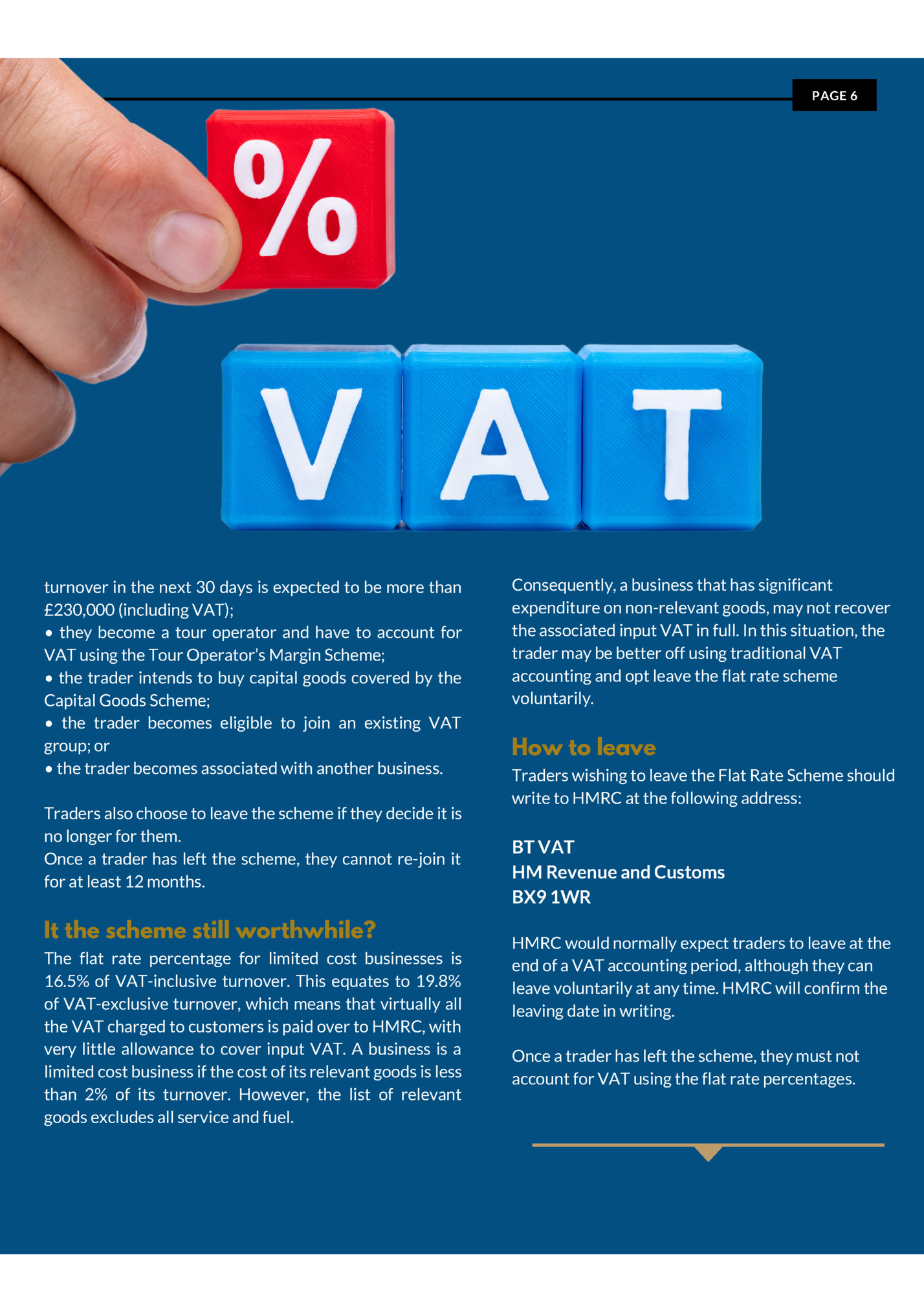
PAGE 7 Auto-enrolment – Re-enrolment and re-declaration of compliance The Covid-19 pandemic has introduced many challenges for employers. However, despite the pandemic, their responsibilities in relation to auto-enrolment remain the same. The employer’s on-going duties include their reenrolment and re-declaration obligations. Every 3 years, the employer must put certain members of staff back into their auto-enrolment pension scheme and complete a declaration to tell the Pensions Regulator that they have done so. This is known as re-enrolment and redeclaration. The key date is the third anniversary of the employer’s staging date or start date. Thereafter, the re-enrolment and re-declaration processes must be undertaken at three-year intervals. Cont on pg 6
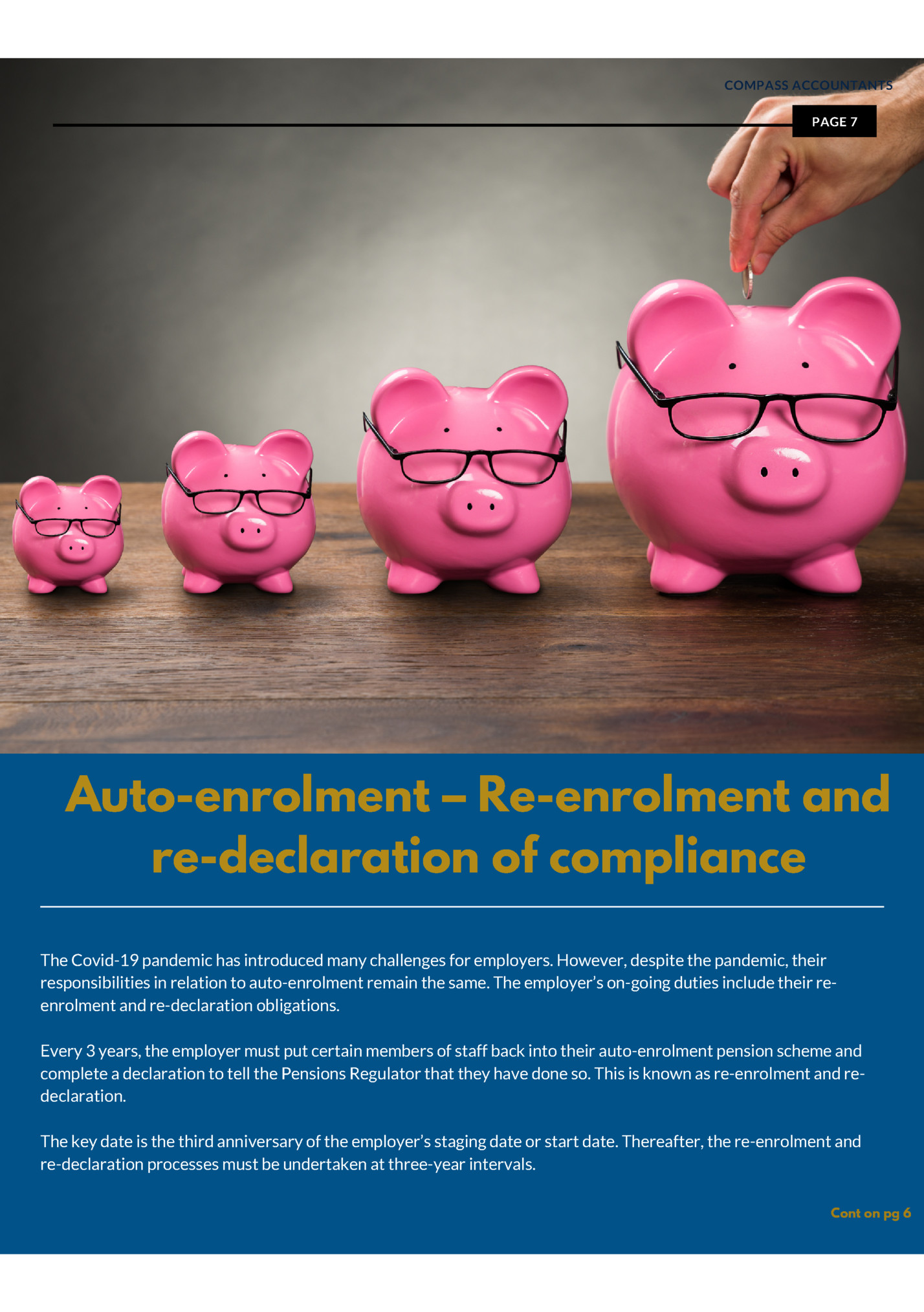
PAGE 8 Re-enrolment Under re-enrolment, the employer must check: • whether they have staff to put back into the pension scheme and re-enrol them; and • write to staff who have been re-enrolled. To do this, the employer will need to assess staff who have left the scheme or who have reduced their contributions. Staff must be enrolled in a pension scheme automatically if: • they are aged between 22 and State Pension Age. • they earn over £10,000 a year (£833 a month, £192 a week). If staff who meet the above criteria have previously opted out, they need to be re-enrolled. Staff who need to be re-enrolled should be put back into the pension scheme within 6 weeks of the re-enrolment date. If this date is missed, it should be done within 6 weeks of the date on which staff were assessed. If an employee does not want to be a member of the scheme, they can opt out. However, they must be re-enrolled if they are eligible at the re-enrolment date; once re-enrolled they can opt out. Opting out lasts only until the next reenrolment date, at which time they must be put back in (but can then opt out again if they want to). Employers must re-enrol eligible staff even if they know they want to opt out. Once staff have been re-enrolled, the employer must deduct employee contributions from their pay and pay them over to the scheme with the employer contributions. The employer must write to staff who have been re-enrolled to let them know, and also to inform them of the contributions that will be paid and that they can opt out if they want to. Re-declaration The final stage of the re-enrolment and re-declaration process is to submit the re-declaration of compliance. This has to be done regardless of whether or not staff have been put back into the pension scheme. The re-declaration of compliance is an online form which confirms to the Pensions Regulator the employer has met their legal obligations in relation to auto-enrolment. The re-declaration of compliance must be filed no later than 5 months from the third anniversary of the duties start date, or staging date, as appropriate. The deadline is the same regardless of whether staff within 6 weeks are assessed within of the re-enrolment date, or at a later date.
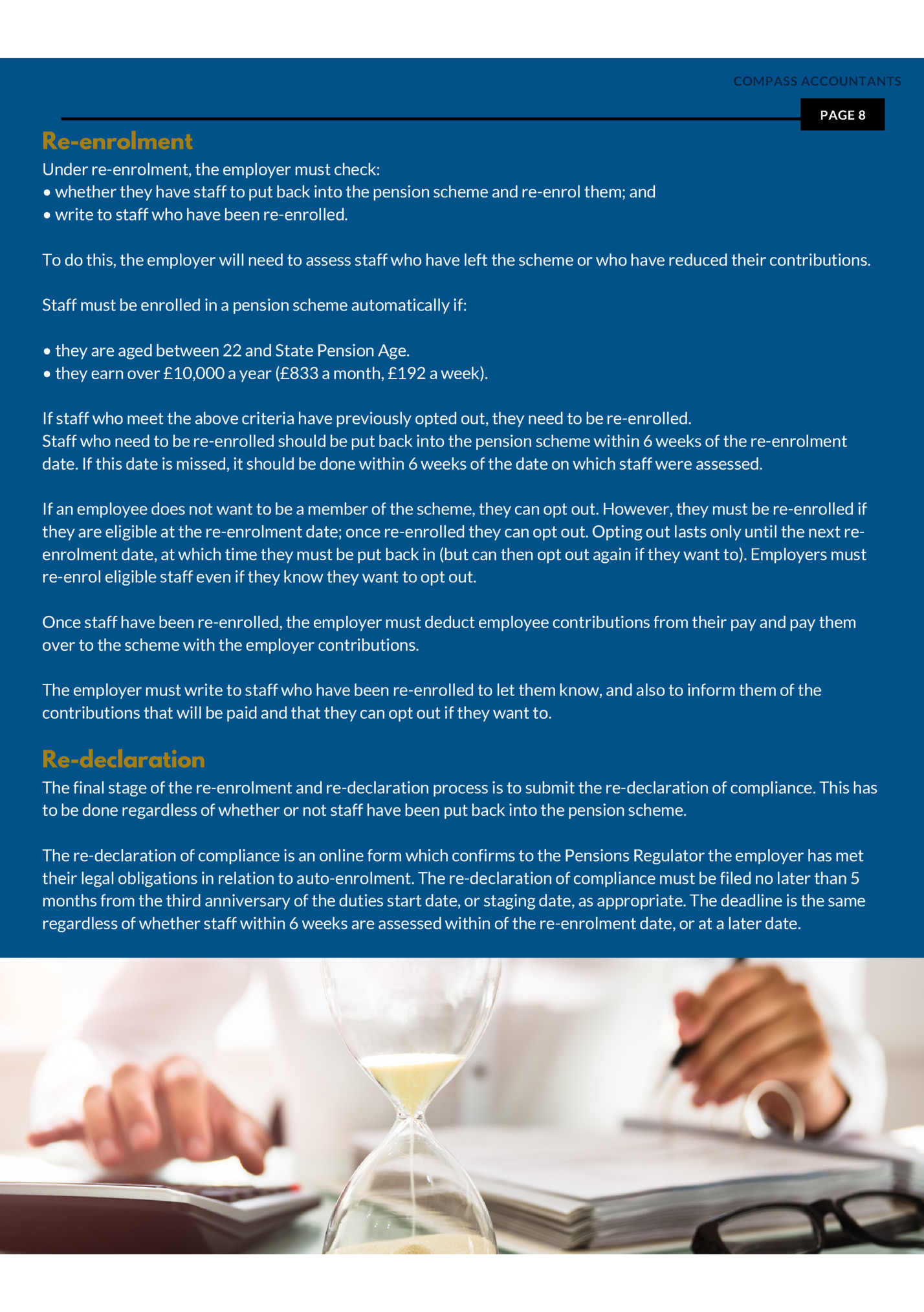
PAGE 9 10 Questions with... We are very pleased to welcome Kerry Sweeney, to the Compass team! Kerry joins us as a Trainee, with three years previous experience in accountancy. She will be working on bookkeeping, VAT, preparing year end accounts and will also be developing her knowledge in personal tax. Kerry said, "After looking for a new role, a recruitment consultant matched me with Compass as they felt they'd be a great match - they were spot on! I feel extremely lucky to have a position with Compass." Here are Kerry's answers to the Compass '10 Questions with...' feature: 1. What is the first thing you would buy if you won the lottery? A house! 2. How did you get into accounting? I started studying for my AAT level 2 in my spare time and then applied for a trainee position. 3. What is your favourite film? Labyrinth 4. What was your first ever job? I first worked as a weekend cleaner at QA Hospital in Portsmouth 5. If you could invite anyone (dead or alive) to your dinner party who would you invite? I would like to invite my family 6. What do you like most about working for Compass Accountants? The people, everyone is so lovely. 9. What did you want to be when you were growing up? Something to do with CSI/Mortuary or forensic type work! 10. Tell us one strange or unique fact about yourself! 7. Which super power would you most like to have? I used to dissect the fish my dad I would like to be able to apparate/disapparate (other wise known as caught and brought home for dinner. teleporting). 8. What is your favourite place in the world that you have been? Thailand
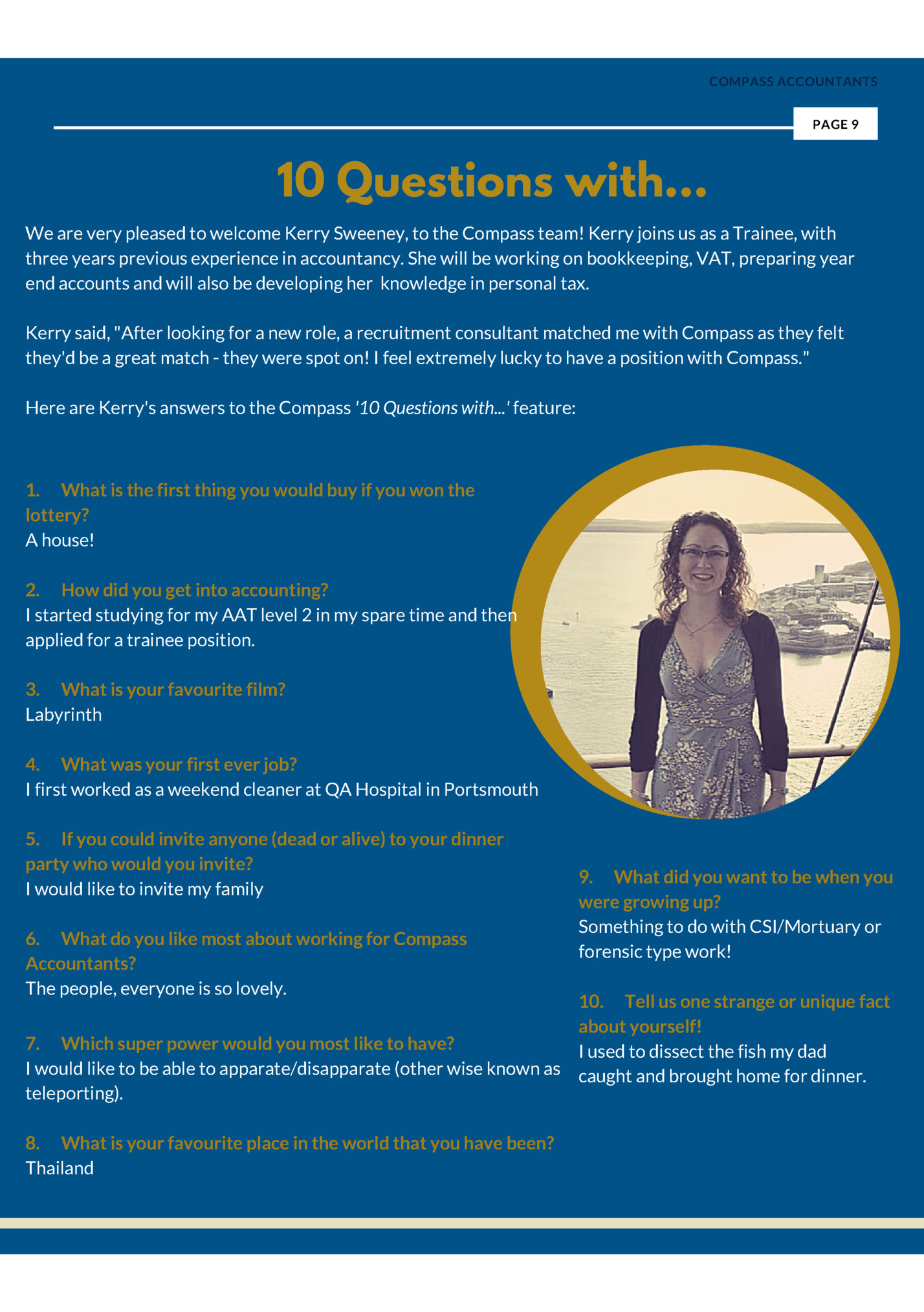
Fleepit Digital © 2021